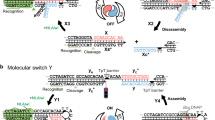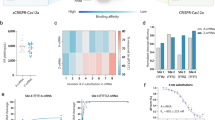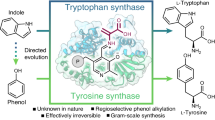Abstract
The ability to manipulate the genome in a programmable manner has illuminated biology and shown promise in plant breeding. Prime editing, a versatile gene-editing approach that directly writes new genetic information into a specified DNA site without requiring double-strand DNA breaks, suffers from low efficiency in plants1,2,3,4,5. In this study, N-terminal reverse transcriptase–Cas9 nickase fusion performed better in rice than the commonly applied C-terminal fusion. In addition, introduction of multiple-nucleotide substitutions in the reverse transcriptase template stimulated prime editing with enhanced efficiency. By using these two methods synergistically, prime editing with an average editing frequency as high as 24.3% at 13 endogenous targets in rice transgenic plants, 6.2% at four targets in maize protoplasts and 12.5% in human cells was achieved, which is two- to threefold higher than the original editor, Prime Editor 3. Therefore, our optimized approach has potential to make more formerly non-editable target sites editable, and expands the scope and capabilities of prime editing in the future.
This is a preview of subscription content, access via your institution
Access options
Access Nature and 54 other Nature Portfolio journals
Get Nature+, our best-value online-access subscription
$29.99 / 30 days
cancel any time
Subscribe to this journal
Receive 12 digital issues and online access to articles
$119.00 per year
only $9.92 per issue
Buy this article
- Purchase on Springer Link
- Instant access to full article PDF
Prices may be subject to local taxes which are calculated during checkout



Similar content being viewed by others
Data availability
All data supporting the findings of this study are available in the article or in Supplementary information files. The next-generation sequencing data for plant and HEK293T cells have been deposited in an NCBI BioProject database and the accession code is PRJNA658855.
Code availability
Analyses of prime-editing mutation frequency were performed using our own script, which can be found on https://github.com/yangyongxing1991/Deep-Seq-Analysis.git.
References
Lin, Q. et al. Prime genome editing in rice and wheat.Nat. Biotechnol. 38, 582–585 (2020).
Lin, Q. et al. High-efficiency prime editing with optimized, paired pegRNAs in plants. Nat. Biotechnol. 39, 923–927 (2021).
Xu, W. et al. Versatile nucleotides substitution in plant using an improved prime editing system. Mol. Plant 13, 675–678 (2020).
Xu, R. et al. Development of plant prime-editing systems for precise genome editing. Plant Commun. 1, 100043 (2020).
Tang, X. et al. Plant prime editors enable precise gene editing in rice cells. Mol. Plant 13, 667–670 (2020).
Marzec, M. & Hensel, G. Prime editing: Game changer for modifying plant genomes. Trends Plant Sci. 25, 722–724 (2020).
Anzalone, A. V. et al. Search-and-replace genome editing without double-strand breaks or donor DNA. Nature 576, 149–157 (2019).
Liu, Y. et al. Enhancing prime editing by Csy4-mediated processing of pegRNA.Cell Res. 31, 1134–1136 (2021).
Li, H., Li, J., Chen, J., Yan, L. & Xia, L. Precise modifications of both exogenous and endogenous genes in rice by prime editing. Mol. Plant 13, 671–674 (2020).
Hua, K., Jiang, Y., Tao, X. & Zhu, J.K. Precision genome engineering in rice using prime editing system.Plant Biotechnol. J. 18, 2167–2169 (2020).
Butt, H. et al. Engineering herbicide resistance via prime editing in rice. Plant Biotechnol. J. 18, 2370–2372 (2020).
Jiang, Y. Y. et al. Prime editing efficiently generates W542L and S621I double mutations in two ALS genes in maize. Genome Biol. 21, 257–266 (2020).
Xu, W. et al. Discriminated sgRNAs-based surrogate system greatly enhances the screening efficiency of plant base-edited cells. Mol. Plant 13, 169–180 (2020).
Kimchi-Sarfaty, C. et al. A “silent” polymorphism in the MDR1 gene changes substrate specificity. Science 315, 525–528 (2007).
Walton, R. T., Christie, K. A., Whittaker, M. N. & Kleinstiver, B. P. Unconstrained genome targeting with near-PAMless engineered CRISPR–Cas9 variants. Science 368, 290–296 (2020).
Miller, S. M. et al. Continuous evolution of SpCas9 variants compatible with non-G PAMs. Nat. Biotechnol. 38, 471–481 (2020).
Chen, B. et al. Dynamic imaging of genomic loci in living human cells by an optimized CRISPR/Cas system. Cell 155, 1479–1491 (2013).
Ran, F. A. et al. Genome engineering using the CRISPR–Cas9 system. Nat. Protoc. 8, 2281–2308 (2013).
Hiei, Y. & Komari, T. Agrobacterium-mediated transformation of rice using immature embryos or calli induced from mature seed. Nat. Protoc. 3, 824–834 (2008).
Yoo, S. D., Cho, Y. H. & Sheen, J. Arabidopsis mesophyll protoplasts: a versatile cell system for transient gene expression analysis. Nat. Protoc. 2, 1565–1572 (2007).
Sheen, J. Signal transduction in maize and Arabidopsis mesophyll protoplasts. Plant Physiol. 127, 1466–1475 (2001).
Acknowledgements
This work was supported by Beijing Scholars Program (BSP041), National Key Research and Development Program of China (2019YFA0802800) and the 13th Five-Year National Key R & D Program of China (2017YFD0102000). We thank R. Chen, Biotechnology Research Institute, Tianjin Academy of Agricultural Sciences for writing the script of analysing the NGS data. We also thank R. McKenzie, Liwen Bianji, Edanz Editing China (www.liwenbianji.cn/ac), for editing the English text of a draft of this manuscript.
Author information
Authors and Affiliations
Contributions
J.Y. and J.Z. supervised the project. J.Y. and W.X. designed the experiments. Y.Y., Q.X., S.Z., L.Z., G.K., F.W., H.Y., W.R., L.L. and X.H. performed all the experiments in plants. B.Y. and C.J.K. performed all the experiments in human cells. B.Z. and C.Z. designed the experiment in human cells. W.X., Y.Y. and J.Y. wrote and modified the manuscript. All authors read and approved the final manuscript.
Corresponding authors
Ethics declarations
Competing interests
The authors submitted patent applications based on the results reported in this paper.
Peer review information
Nature Plants thanks Yiping Qi and the other, anonymous, reviewers for their contribution to the peer review of this work.
Additional information
Publisher’s note Springer Nature remains neutral with regard to jurisdictional claims in published maps and institutional affiliations.
Extended data
Extended Data Fig. 1 Optimized prime editors for precise genome editing in HEK293T cells.
a, Schematic representation of two PE vectors in HEK293T cells, cPE and nPE. b, Genomic sequences after prime editing using different RT-S and RT-M templates at the three endogenous targets, counting the first base 3’ of the pegRNA-induced nick as position +1. Bases desired to be edited are highlighted in red and the assistant bases are marked in blue.
Extended Data Fig. 2 Prime editing efficiency in HEK293T cells.
a, Prime editing efficiencies in HEK293T cells using four different strategies. Values and error bars reflect mean ± s.d. of n = 3 independent biological replicates. b, Fold of enhancement of multiple-nucleotide substitutions in the RT template on cPE and nPE.
Extended Data Fig. 3 Detailed editing alleles in HEK293T cells.
Detailed editing alleles edited with cPE-RT-S and cPE-RT-M strategies at the three targets in HEK293T cells was analyzed with CRISPResso2 after Hi-Tom sequencing. For each target, the reference sequence from this region is at the top. Negative control indicated a non-targeting pegRNA transfection. RT-S and RT-M strategies were indicated by the distance from the nick and the substituted bases. Edited bases in the cells were indicated with bold font. All alleles observed with frequency ≥1.5% are shown.
Supplementary information
Supplementary Information
Supplementary Tables 1–7
Rights and permissions
About this article
Cite this article
Xu, W., Yang, Y., Yang, B. et al. A design optimized prime editor with expanded scope and capability in plants. Nat. Plants 8, 45–52 (2022). https://doi.org/10.1038/s41477-021-01043-4
Received:
Accepted:
Published:
Issue Date:
DOI: https://doi.org/10.1038/s41477-021-01043-4
This article is cited by
-
Targeted genome-modification tools and their advanced applications in crop breeding
Nature Reviews Genetics (2024)
-
CRISPR technologies for genome, epigenome and transcriptome editing
Nature Reviews Molecular Cell Biology (2024)
-
Efficient and precise genomic deletion in rice using enhanced prime editing
aBIOTECH (2024)
-
Genome editing based trait improvement in crops: current perspective, challenges and opportunities
The Nucleus (2024)
-
Efficient and versatile multiplex prime editing in hexaploid wheat
Genome Biology (2023)



